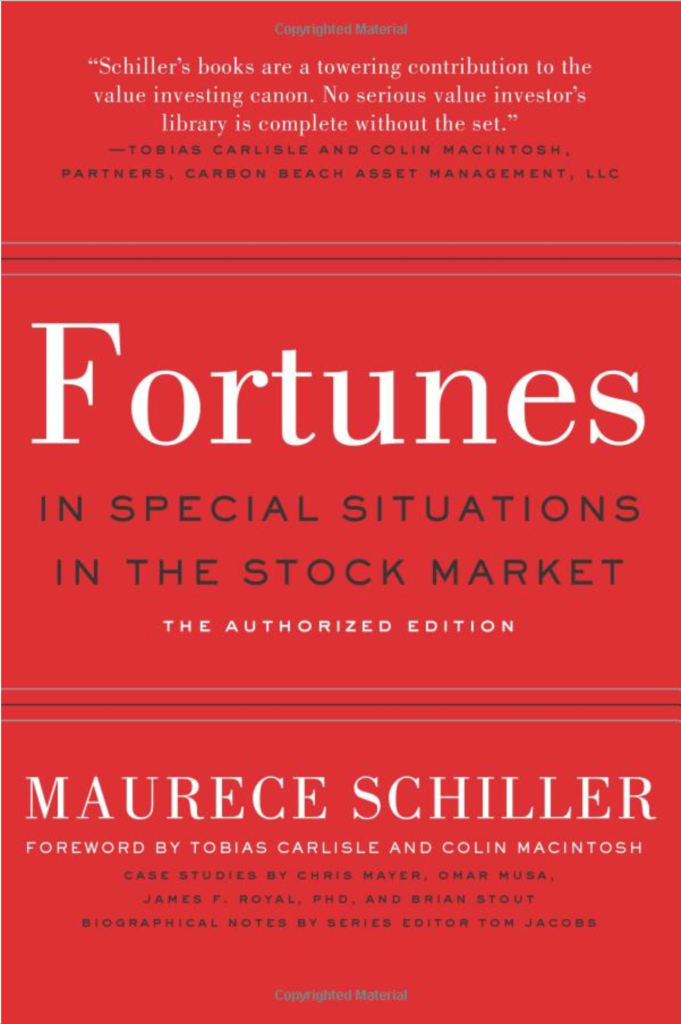Tom Jacobs recently published Maurece Schiller’s Fortunes in Special Situations in the Stock Market: The Authorized Edition. We provided an endorsement and the following foreword:
Beginning with Maurece Schiller’s series is the original and definitive guide to special situation investing. It is not an embellishment to say it stands shoulder-to-shoulder with the three other great works in the value investing canon—Graham-and-Dodd’s Security Analysis, Benjamin Graham’s The Intelligent Investor and Phil Fisher’s Common Stocks and Uncommon Profits. Incomplete, and thought partially lost for decades, investment advisor and author Tom Jacobs has rediscovered the full set, arranging Schiller’s original work alongside fascinating biographical detail on the man.
Special situation investing remains a mystery to many. What are special situations? They are now as they were in Schiller’s time: corporate event-driven opportunities. They take many forms, but each possesses three defining characteristics: First, the return on investment depends on a corporate act— board-level action like a merger, takeover, liquidation, spin-off, or similar—rather than an improvement in the underlying business. Second, the return on investment can be calculated with something approaching mathematical certainty. When combined with a known timeline, this calculation can be converted into an annualized figure. Third, the security must be undervalued. This reduces the risk and produces the opportunity type most highly prized by professional investors—asymmetric returns, meaning low or no downside, and a higher, surer upside.
The implication, and the main attraction to special situations, is that the return doesn’t depend on the direction of the stock market. This is the reason its practitioners love the art. A special situation turns on the execution of the corporate event, not on whether the stock market goes up or down. The vagaries of the stock market create the mispricings that lead to the opportunities, but the special situations method is only incidentally “stock market” investing.
Two of the world’s best-known value investors—Warren Buffett, and Joel Greenblatt—recorded their highest returns in special situations. Buffett averaged 29.5 percent per year in his twelve years from 1956 to 1969 as general partner of the Buffett Partnerships. And Greenblatt averaged 40 percent per year from 1985 to 2005 in his Gotham Capital. Both records were achieved as special situations investors. Only too much capital—the best kind of problem—stopped them from persisting.
The essence of special situation investing is curiosity—a willingness to look beyond stock screens and turn over rocks, pull on loose threads and unearth rich veins below the surface. It demands only a little knowledge, but a lot of shoe leather, elbow grease, and midnight oil. This is why Schiller was rare, and why practitioners are rarer still today. But for those small tolls, its rewards are incommensurately greater.
As fellow special situations practitioners, we are delighted to present the classic masterworks, and to see Schiller restored to his rightful place among the investing luminaries. Maurece Schiller’s books are a towering contribution to the value investing literature. No serious value investor’s library is complete without the set.
Pick up a copy of Fortunes in Special Situations in the Stock Market: The Authorized Edition from Amazon here.
For all the latest news and podcasts, join our free newsletter here.
Don’t forget to check out our FREE Large Cap 1000 – Stock Screener, here at The Acquirer’s Multiple:



